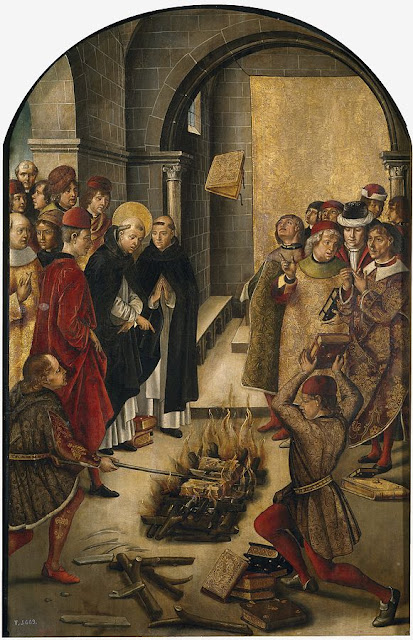There's something hidden in this painting that made me gasp.
Do you see the shadowy form of a skull hidden in the depths of Filippo Tarchiani's St. Dominic in Penitence?
 |
| St. Dominic in Penitence by Filippo Tarchiani. A public domain image through Open Access for Scholarly Content. The Metropolitan Museum of Art, Gift of Brian J. Brille, 2015. www.metmuseum.org/art/collection/search/440900 |
Do you see the shadowy form of a skull hidden in the depths of Filippo Tarchiani's St. Dominic in Penitence?
 |
| Excerpt from St. Dominic in Penitence by Filippo Tarchiani highlighting the skull. Photo by blog author. |
Why is there a skull in this painting almost hidden in the dark? Before I answer that question let’s back up and look at the
main figure in this painting—St. Dominic.
St.
Dominic
In Tarchiani’s painting St.
Dominic (1170-1221 C.E.) is shown whipping himself as an atonement
for his sins. Penitent self-flagellation was a typical act for St. Dominic, who
was arguably the most penitent saint. St. Dominic frequently stayed up all
night engaging in penitent acts like the one shown. Sometimes,
he was so over-zealous in his penance that his friends intervened to stop him
from hurting himself.
Aside from his penance,
St. Dominic was known for being kind, converting heretics, taking the vow of
poverty, and being extremely studious. During his life, St. Dominic worked to
evangelize the Albigenses, a group of particularly heinous heretics hated by
the Catholic Church. St. Dominic was also the founder of the Dominican Order.
 |
| St. Dominic de Guzman and the Albigenses by Pedro Berruguete. A public domain image. Source. |
How do we know that the
man in Tarchiani’s painting is actually St. Dominic?
Deciphering
the Symbols
St. Dominic was an avid practitioner
of penance, and the fact that the man in Tarchiani’s work is flagellating
himself is the first big clue that the subject may be St. Dominic.
The man has a faint halo
around his head with a small red star on it. We all know that halos are used to
indicate holiness, but why the red star? As legend has it, when baby St.
Dominic was baptized a glowing star appeared on his forehead. Artists, like
Tarchiani, often place a red star on the halo of St. Dominic to help reveal his
identity.
 |
| Excerpt from St. Dominic in Penitence by Filippo Tarchiani highlighting the halo and star.Photo by blog author. |
As a child, St. Dominic
remained as holy as his baptism predicted. His favorite activities were serving
at the altar, reading, and penitent prayer. In St. Dominic in Penitence the saint is shown kneeling in front of an
altar with an open book propped up against it while praying in penance. The
open book also symbolizes spreading wisdom and truth, which St. Dominic did when
preaching to the heretical Albigenses.
 |
| Excerpt from St. Dominic in Penitence by Filippo Tarchiani highlighting the altar and book. Photo by blog author. |
The hidden skull itself
is an attribute of penitent saints like St. Dominic because it is a reminder of the shortness of life and the inevitability of death. The skull in this work, similar to death, may not be the focus of our thoughts, but it is always present.
There are more symbols in
St. Dominic in Penitence, like the
hourglass, the vase of flowers, and the window. I’ll delve deeper into these
symbols and the story they tell in my next post.
No comments:
Post a Comment